Welcome to Field Notes!
It’s summertime in Georgia in the mid 1980’s. The sun beats down onto the roof of our solid green Buick Century station wagon. I have no idea how long we’ve been driving, but coming from our suburb near Atlanta, it has been much too boring of a ride for a kid. At 8 or maybe 9 years old, I am done with sitting still and want to get out. My younger sister occupies the back seat with me, unrestrained as all kids of the 80’s were. Somehow, she isn’t nearly as antsy.
We lost the radio station a while ago, but that’s ok. Dad would’ve been listening to talk radio, anyway. Now we roll forward slowly only to the sound of tires crunching along a one lane red dirt road. Dust clouds rise behind us. The two small houses we pass look like they’ve been forgotten here by earlier generations, occupied only by an apathetic dog lying panting in the shade.
“We’re here” Dad says, but this spot in the road is at the center of nowhere and the road still stretches on in both directions. Sunlight glints off of the rim of his glasses. He edges the station wagon halfway into the grass on the shoulder and shuts off the engine. I hop out in a rush before Mom and my sister begin to move.
An old fence of weathered wooden stakes and rusted barbed wire parallels the road. It holds back a thin line of trees that form a broken canopy above. The shade is welcome, but the cicadas’ loud and irritable buzzing from the high branches is not.
Beyond the line of trees stretches a sun beaten open field. It is a cow pasture, whose occupants have retreated to whatever shelter from the sun they could find.
“There.” Dad points out into the field, where a small island of trees stands out prominently in the sea of tall grass. “That’s the Hogan Family Cemetery.”
We carefully maneuver over a low section of barbed wire and step from the shade into the full force of the afternoon sunlight. My legs instantly drain of energy. Breathing becomes difficult and sweat erupts across my forehead.
I don’t remember the walk across that field, but I do remember the tree thicket and a massive oak tree that formed its centerpiece. Dad points out an ancient arrangement of stones. Small rocks lay jumbled together to form an indistinct square frame on the earth. Inside of the frame stand three eroded headstones in a line. Nearby are smaller stones, deliberately placed. Foot stones? Maybe the headstone of a child? There are also a couple of unmarked shallow depressions in the ground. Dad explains that the old wooden caskets have rotted away and graves have sunken in.
Like so many memories from early childhood, they do not reach any point of conclusion or come to a definite end. They are snapshots of time, with the rest of the story having burned away like fog before the rising sun.
I have no recollection from that day of names on the headstones. No remembrance of leaving that stand of trees. We never returned after that day. Perhaps, after all of these years, a part of me remained there amongst my unknown kin.
Dad would occasionally mention an ancestor, Wiley T Hogan, who fought in the Civil War, but I don’t think he knew many more details than that. Then, in my freshman year of college, Dad passed away. Cancer. I never learned from him the location of the Hogan Family Cemetery.
Step back into the present with me. I can’t say what brought Wiley T Hogan’s name back to mind in November 2024, but there it was. On a whim, I plugged his name into an internet search.
The internet is such a wild thing! For all of its distractions, online shopping decadence, and sensational negative influences, it occasionally spits out a jewel. In this case I was shown findagrave.com. There was a record for Wiley, born in 1823. He served as a private during the Civil War, Company F, 9th Regiment, Georgia State Guards. Apparently, he was furloughed due to illness in 1864, caught measles on his way back, and died shortly after arriving home. He was 41 years old.
The website provided a photo of Wiley. And a photo of his headstone in the Hogan Family Cemetery that exactly matched my memory from childhood. If that wasn’t enough, it also gave a link to the GPS coordinates for the cemetery in Google Maps.
I went to college in Athens, Ga, back in the mid to late 1990’s. That town is just over an hour’s drive east of where I grew up. Some chaotic years followed in which I bounced around a bit, but eventually I came back to Athens, where I settled to live my adult life. I landed there more out of circumstance than planned decision, but the roots quickly started to grow.
That circumstance just germinated into serendipity. I asked Google Maps for directions to the cemetery. It plotted my course precisely, and the drive from my home was less than 30 minutes.
It took until after Christmas to find a day when me and my kids were all available to go look for the cemetery. In the meantime I showed them the photo of Wiley and of the graves from the internet. I told them the story from my memory. We were all eager to find our ancestors.
Slate grey skies loomed overhead on a chilly morning in late December as we set out on our quest. The route started along familiar roads leading into the more rural areas. Even just 20 years ago, this was almost all farmland. Cattle, corn, or maybe fields of beans. Cotton is still grown around here, and we pass tracts land covered in dry brown stalks topped with tufts of white.
We follow the roads in a direction I haven’t gone before. Farmland is vanishing. Call it the affluence of our modern age, the ease of travel, or anything else. Everywhere, we see agricultural land redeveloped into subdivisions.
Land here is inexpensive. Cheap development allows people to buy climate controlled homes unheard of just a couple of generations ago. They are willing to take lengthy commutes to jobs in the urban areas of Athens or even Atlanta, because they ride in the luxurious comfort of modern automobiles. Because of these conveniences, people are living in locations that would not have been possible for their circumstances just a few years ago. Whether it is cookie cutter homes or McMansions that are being built is irrelevant. The farmland is gone, just the same.
I’m not suggesting that modern agriculture practices are natural or good. I am saying that at I remember when I could drive 10 minutes from my town and see fields of wheat rippling in the breeze and perhaps even a herd of deer near the tree line in the evening. I miss that.
I almost take a wrong right turn into an undeveloped subdivision. That driveway wasn’t in Google Maps. My road is the next one. As soon as I make the turn onto that narrow red dirt lane I know we are here.
All of the land to the right of the road has been clear cut in preparation for development. It appears that progress stalled, though, because waist high grass dominates the open acres. But, this little dirt road has remained unchanged over the years. I drive slowly, uncertain of what to expect. We pass the tiny old houses from my memory, and one new massive house set behind them.
Then we come to the end of the road. The development to the right of the road makes a 90 degree turn, consuming the rest of our route. This is also not updated in Google Maps. From what I can see, it looks like the new subdivision sprawls over the cow pasture that was once here, and the Hogan Cemetery as well. We have to check it out. It is time to walk.
My kids and I step through the high grass. There are paved roads and a cul-de-sac forming a framework for the subdivision, but no buildings have been started. We trek down a drainage ditch, up the other side and around a border of trees. Several deer spring away in the distance.
There. That copse of trees. I saw it one time 40 years ago, but know it instantly and the sight gives me goosebumps. Amid the development it still stands, and we hurry towards it.
Another world exists amongst these trees. Fallen leaves and a green groundcover shrub form the floor. The massive old oak is still there, split and half fallen, but smaller trees still form the ceiling. Old fence posts stand up among the leaf litter on the ground, covered in rusty ancient barbed wire and some newer barbed wire. Who put that there, and when?
The headstones are obvious, arranged in a line within the nearly hidden frame of smaller rocks on the ground. The larger one to the left is Isam Hogan, Wiley’s son. The center stone has fallen flat and is so weathered it cannot be read. To the right, leaning and propped by a rock, is the headstone for Wiley T Hogan, died in 1864.
I know from the findagrave.com site that Wiley’s father is also planted in this square of earth. So, that center stone is very likely his. Isham Hogan, born in 1780 and buried here in 1831, almost 200 years ago.
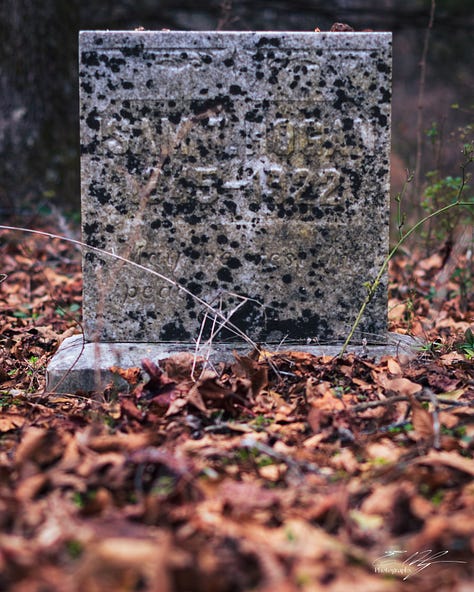
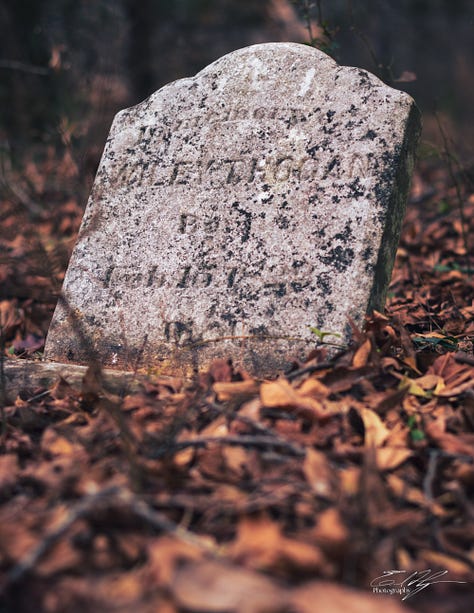
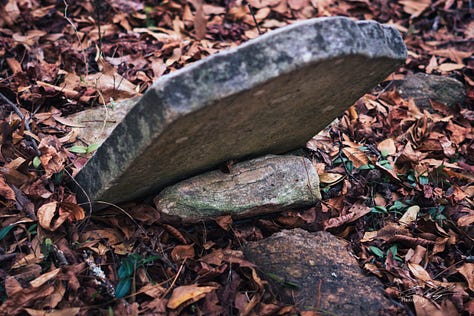
So what is this story really about? It was a little adventure one morning to drive my kids somewhere not too far away, to see a place I visited long ago, not quite knowing what we’d find today. But, the plot of that story took me 40 years to produce. And the story itself, from Isham to my kids, covers a span of 7 successive lifetimes.
I have a strange and conflicted feeling standing here, looking at the tombstones of my ancestors. It is heightened as I watch my kids examine the old stones and then explore the areas nearby.
On the one hand, I have a deep sense of connection; of belonging here. But I don’t know any of these men, or know what type of people they were. So maybe I just feel connected to a memory from childhood. The vividness of that memory, and how close this place still looks to it, is surreal.
Maybe this is a story about impermanence. Genes are handed down through the ages. We all make the best of what we are given, but then we add our own special mix when we hand them off to the next generation. So what does lineage amount to, if the genetics slowly change? And its common to think that we should live in a way that makes our ancestors proud. Maybe we should, but what does that really mean?
I’d really like to think that Wiley was a courageous and noble defender of what he believed was right. That sounds like a forefather I would like to honor by living my own best life. But we now know that the world he inhabited and way of life in the South back then were deeply unjust and flawed. Its good that things changed. So, am I justified in thinking the best of Wiley and of what I’ve inherited from him?
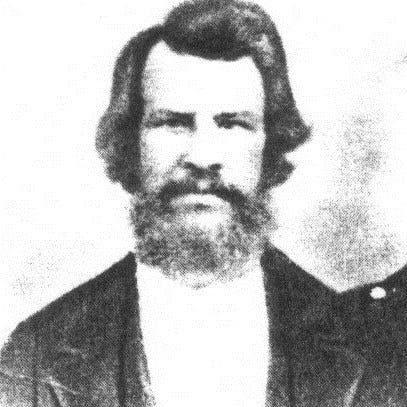

I imagine the photo of Wiley above was taken fairly close to the year of his death in 1864. I took that selfie on the right in April, 2024. That little gap between the photos? It represents a span of about 160 years. But in that gap you will also find the invention of the automobile, the telephone, electric lights, airplanes, atomic bombs, televisions, computers, space travel, the internet, and artificial intelligence. It is a different world, and the changes are accelerating.
I don’t know what I expected to see when I laid eyes on this cemetery once more, but it certainly wasn’t finding it in the middle of a subdivision. It’s sort of ironic, though, that the started-then-stalled state of development resulted in empty lots with overgrown grass which made the whole area look pretty close to the way I remember that old cow pasture.
Remember, this is ultimately a story of impermanence. I am inexpressibly grateful to revisit this memory on this day and hope that I’ve now handed the memory, somewhat intact, down to my kids. But, some day soon the Hogan Family Cemetery will be a part of someone’s backyard, protected only by covenants, easements, and maybe some HOA rules. It is on Lot 9, to be exact, if anyone is interested in purchasing it and preserving it for me.
Whatever happens, the memory will be lost to time. Perhaps the genetics and the good people who come along after me, crafting themselves out of the genes they’ve been handed, will carry on.
Thanks for bearing with me on this personal piece. It ended up being a much larger post than I thought it would. I raised a lot of questions at the end that are left unanswered. I don’t even have a close enough answer to offer. I would really love to hear your thoughts on this, so if this sparked anything for you let me hear it-
Ok, so last week I wrote that I will not try to sell photo prints on line anymore. Now, let me elaborate.
I want to share my writing and photography with you here in Field Notes for free. I’d rather openly offer my ideas and art and have the chance to discuss them with you than paywall posts that only paid subscribers can get.
I still could really use some kind of financial return on all the work I’m putting into this, though. This is why I have the paid subscription option open. I choose to view a paid subscription as a recurring contribution towards the work that I’m doing, because you like what I do and it brings you some kind of value. I’m also including a link for one time contributions of any amount for the same purpose.
Now for the photos. I am still trying to sell my photographs. What I would like to try is offering them as full resolution digital downloads. Don’t think of is as that, though. Think of it as purchasing a license to use that photograph for an unlimited time frame, for personal use. Want to use it for your computer desktop background? Go for it! How about your phone wallpaper? Great idea! Here’s the other thing- you can take that full resolution file and have it printed wherever you want. Take it to a local printer to eliminate shipping costs entirely. If you’re concerned about print prices, you can have it printed at Walmart. You could do all of the above with that license, and then do it again 50 years from now, if you so choose.
Personal use does not cover some things, though. You can’t re-sell my images or claim them as your own. You can’t give them to anyone else to use (other than a one-off gift). And you can’t use them for a multi-million dollar commercial ad campaign. We’d have to have a different conversation first!
Right now I’m thinking the price of one of these digital images is $10. I think that’s reasonable considering all that went into the photograph and all that you are allowed to do with the image. I’ll slowly add more images that I offer, week to week.
Here’s the deal. Since I don’t offer any premium content, I am extending 50% off of these digital downloads, and occasional free ones, to anyone who signs up for a recurring contribution to Field Notes via a paid subscription.
I really hope this is enticing to some of you, in a way that benefits all involved. If not, no worries. Keep on reading as before. I’m not a good salesman and won’t pitch this too hard after today.
I’m currently offering A Path to Warm Light and Devil’s Den Falls in my photo store. A Path To Warm Light is free to paid subscribers. The discount/free code is available on the tab in the navigation bar on my homepage.
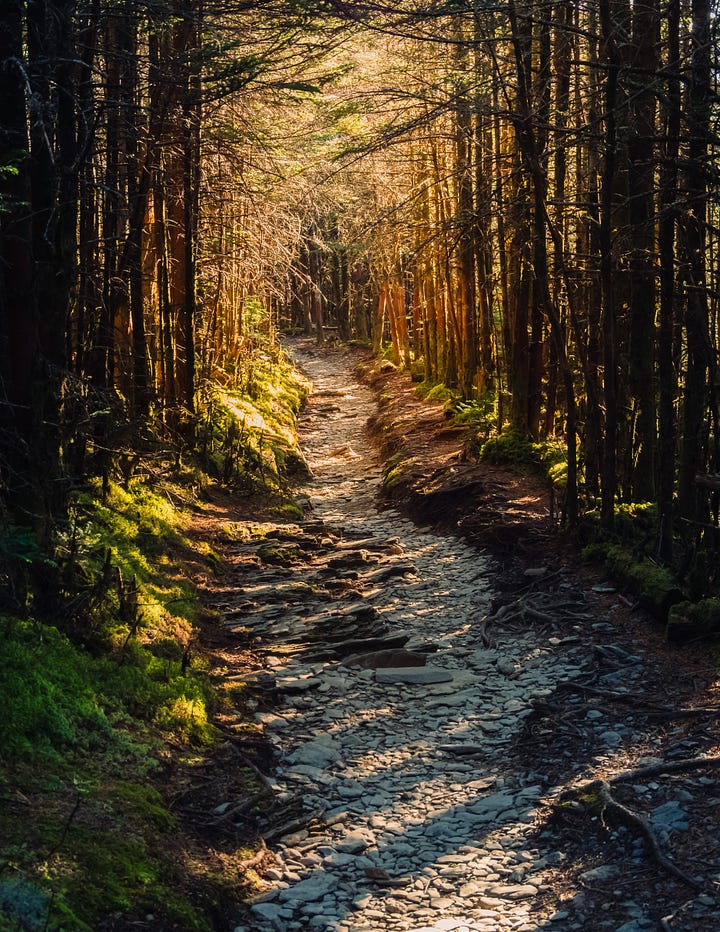
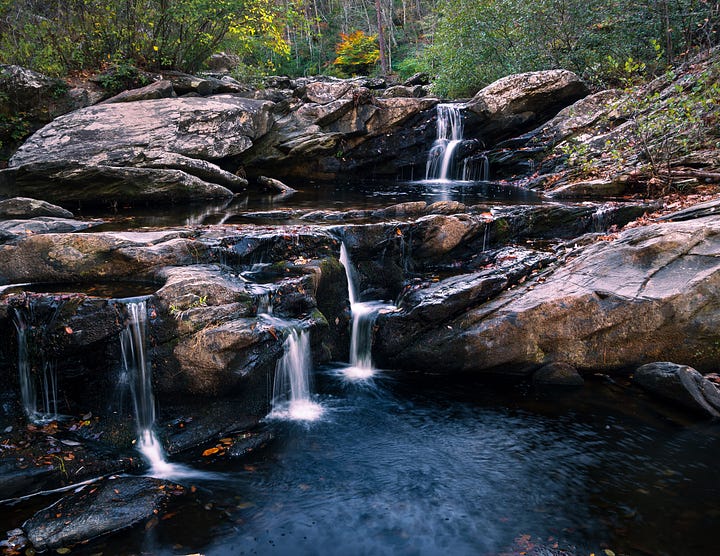








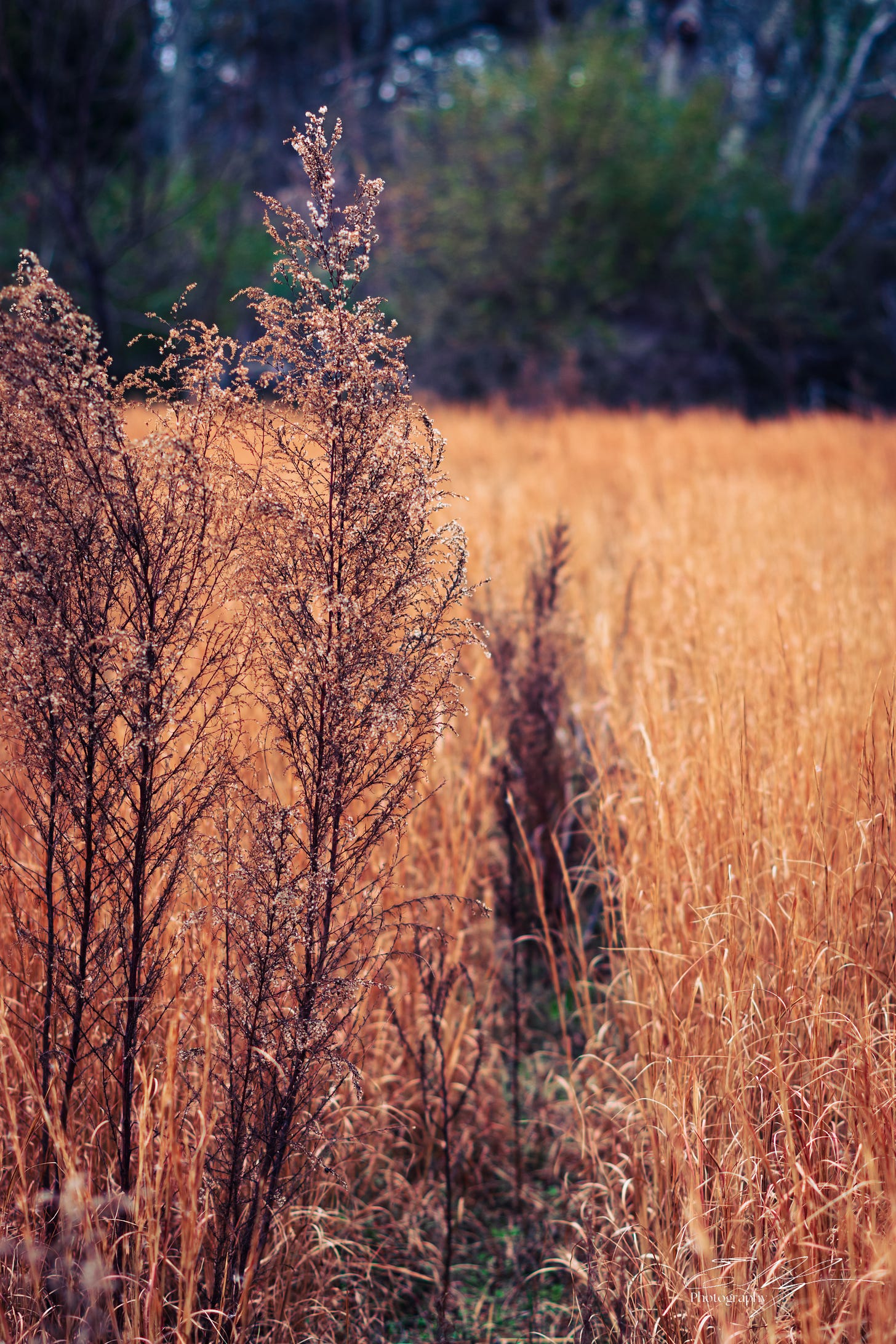

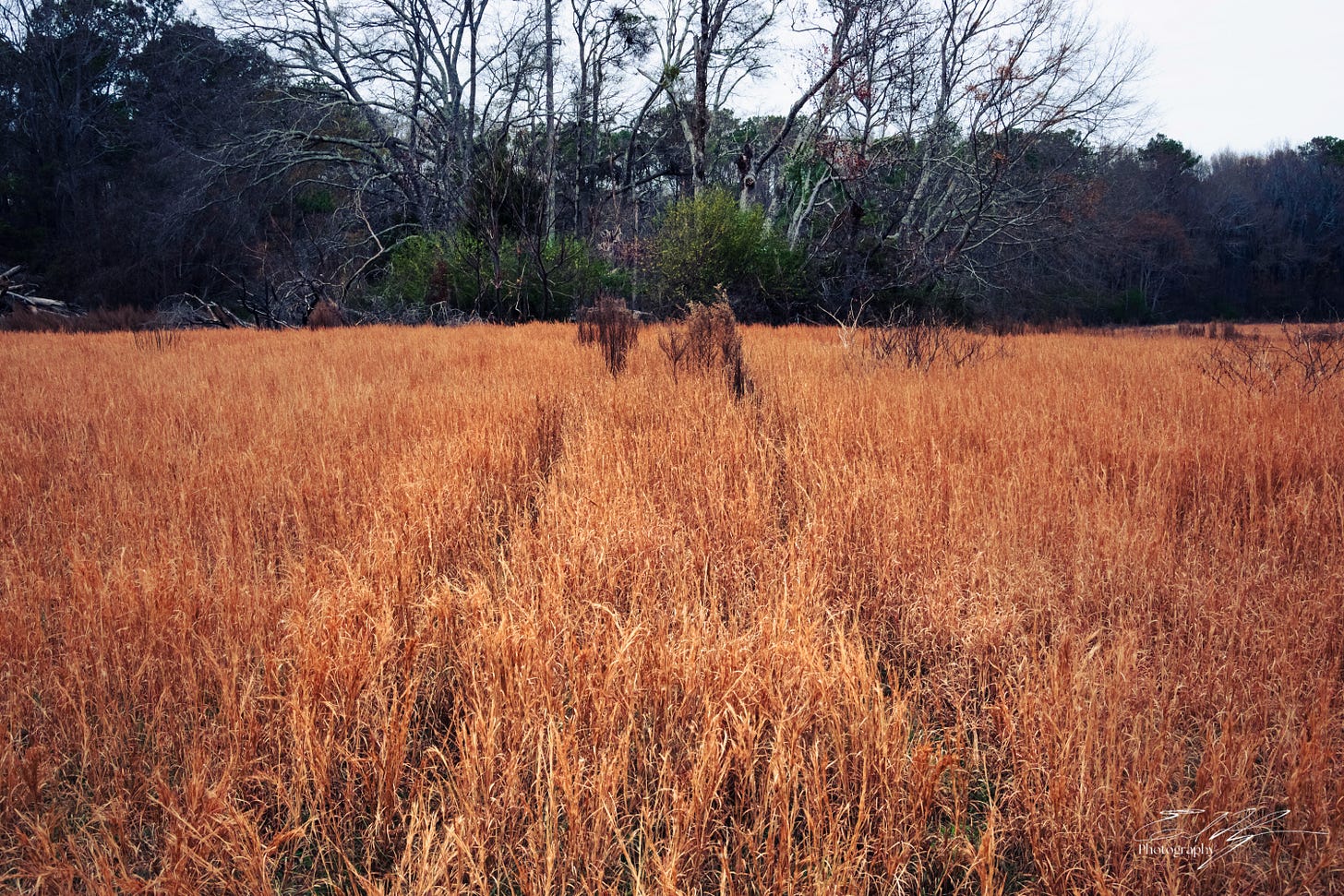

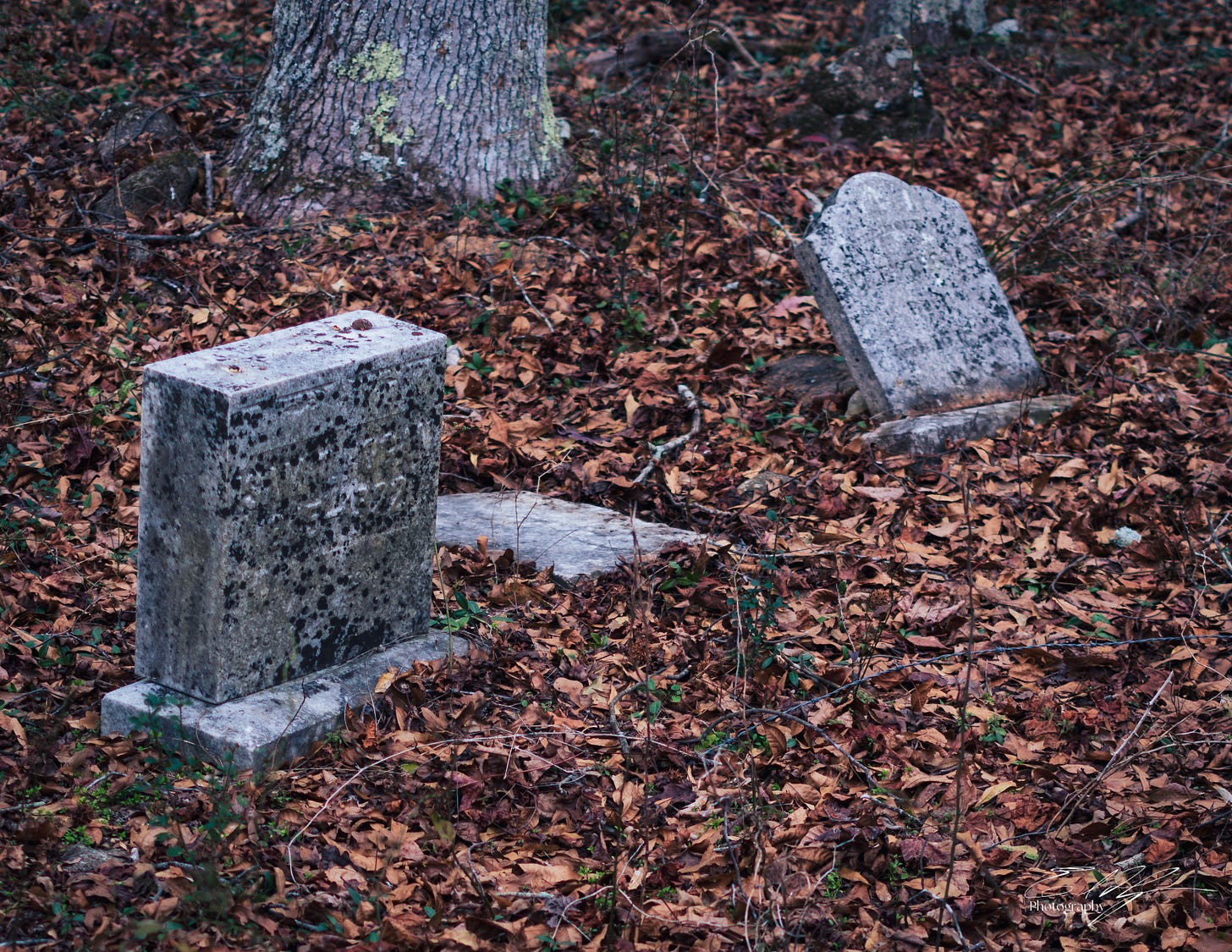
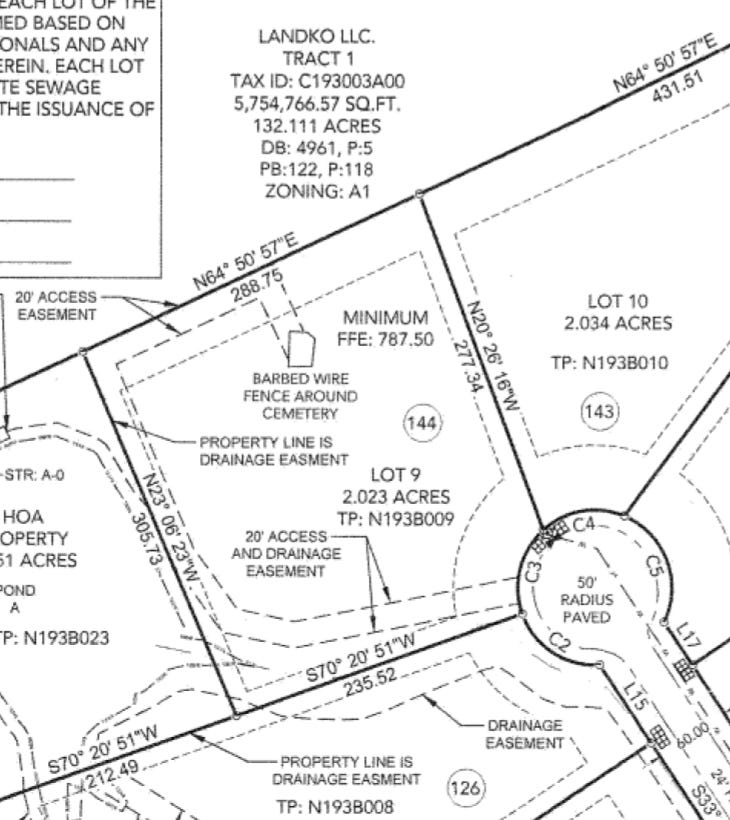


This was a fascinating piece! I’ve had a similar experience as a young person going far into the country in south-western Virginia to visit a similar family cemetery up on a mountain ridge, of my great-great’s (which also dates back to the Civil War). The old family farm up on the Ridge was divided up among the family members many years ago, and eventually a small piece came to belong to my parents … who then offered it to me. So I now own a small sliver of mostly useless property, just off a major highway, on the complete opposite side of the country from where I now live. We pay a small amount of property taxes on it every year and in this way I cling to a tiny piece of my heritage and my ancestor’s old family property. Your experience which you shared was very relevant! Thanks for sharing!
Great story Erik. It is always good to reflect on the lives of our family members who came before us - how different their life would have been, how similar.